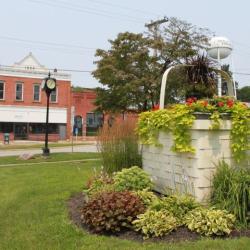Part of our Time Traveler Series.
 It may surprise many readers to learn that the Free Love movement did not begin in the mid-20th century. These types of movements have occurred throughout history, and while the “hippie” movement may be the most well-known currently, there was quite a push for this type of thinking a century before! Not only did this 19th century movement have communities scattered across the country, one of the most prominent was in our own backyard: Berlin Heights.
It may surprise many readers to learn that the Free Love movement did not begin in the mid-20th century. These types of movements have occurred throughout history, and while the “hippie” movement may be the most well-known currently, there was quite a push for this type of thinking a century before! Not only did this 19th century movement have communities scattered across the country, one of the most prominent was in our own backyard: Berlin Heights.
Before we delve into some details of the Berlin Heights Free Love community, let’s take a quick journey into the larger history of this movement in the United States. The 19th century saw a development of many new spiritual traditions, utopian ideas, and various forms of communal living were attempted by many of these new groups. Spiritualism and the Church of Latter-Day Saints are both larger examples of such movements, but many smaller communities existed as well.
The Free Love movement in the 19th century U.S. has its roots in philosophical ideas that marriage (or lack  thereof) should be an individual choice, and that relations of any kind should be based on individual freedoms. These ideas began coalescing in small groups and by the mid-19th century the term Free Love had been coined by John Humphrey Noyes, who started the free love utopian community of Oneida (a very interesting community to research as well!) in 1848 in upstate New York. According to Noyes the community rejected “conventional marriage both as a form of legalism from which Christians should be free and as a selfish institution in which men exerted rights of ownership over women.”
thereof) should be an individual choice, and that relations of any kind should be based on individual freedoms. These ideas began coalescing in small groups and by the mid-19th century the term Free Love had been coined by John Humphrey Noyes, who started the free love utopian community of Oneida (a very interesting community to research as well!) in 1848 in upstate New York. According to Noyes the community rejected “conventional marriage both as a form of legalism from which Christians should be free and as a selfish institution in which men exerted rights of ownership over women.”
As these ideas began to spread, several other communities with the focus of free love formed in New York, as well as Ohio. In the 1850s, the Universalist Hall in Berlin Heights began to host meetings on various topics of spiritualism and other philosophical hot topics of the time. Through visitors to the hall and the movements within spiritualism, and the women’s suffrage movement, the ideas of free love became quite the conversation. Town resident Francis Barry began hosting meetings on the ideas of the free love movement and eventually, with several others in the group, determined to establish a free love community in Berlin Heights! One of these men,  John Patterson, even began producing free love publications from the community such as the magazine Social Revolutions.
John Patterson, even began producing free love publications from the community such as the magazine Social Revolutions.
By 1857 interest was growing, and Saphronia Powers rented the Davis Hotel (on the site of what is now the Berlin Heights Post Office) to house free lovers coming to visit the community. Things grew quickly, and during that same year a conference based around the ideas of free love was hosted in town. The free love community moving into the area found jobs and industry lacking and began paving their own way, buying property and starting businesses. James Clay opened a storefront downtown, George Carpenter built and ran a grain mill, and Samuel Patterson started a basket factory, the Berlin Fruit Box Company, which was in business until 2012.
 The town became divided as some long-time residents did not agree with the free love philosophy. The division of the community became apparent, and led the free love community to start their own school on the upper floor of James Clay’s store. The later months of 1857 saw Francis Barry attacked by a group of local men while trying to deliver his magazines to the local post office. The anti-free love group even went as far as to hire “thugs” from Sandusky to come and rough up (or worse) the free love community. The community, however, was warned and a telegraph message was sent to Sandusky telling the men their services were no longer needed. In addition to these issues, several court cases were brought against the group, none of those I found were successful.
The town became divided as some long-time residents did not agree with the free love philosophy. The division of the community became apparent, and led the free love community to start their own school on the upper floor of James Clay’s store. The later months of 1857 saw Francis Barry attacked by a group of local men while trying to deliver his magazines to the local post office. The anti-free love group even went as far as to hire “thugs” from Sandusky to come and rough up (or worse) the free love community. The community, however, was warned and a telegraph message was sent to Sandusky telling the men their services were no longer needed. In addition to these issues, several court cases were brought against the group, none of those I found were successful.
The group, while all connected, were not overly organized, and the community dissolved over the next 10 years, however, many of the families stayed in the region for generations, some families still remain in the area.
Special thanks to Terri Lowry and the Berlin Heights Historical Society for their assistance, knowledge, and willingness to share research and photos!



